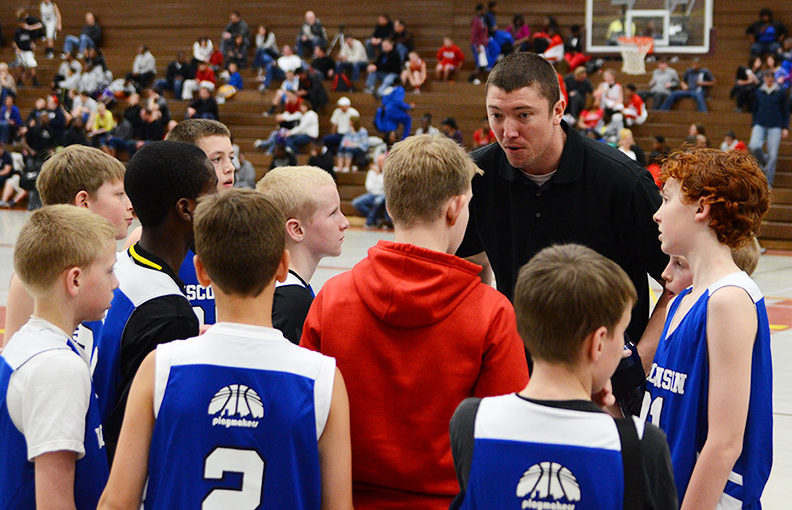1 Prep Football Season, 1,800 Hits To The Head
But a new study of an Indiana high school football team hints that some athletes are suffering brain injuries that go undiagnosed, allowing the players to continue getting battered, unaware of the possible cognitive damage that has been done.
Of 21 high school players monitored for a full season by a team of researchers from Purdue University, four players who were never diagnosed with concussions were found to have suffered brain impairment that was at least as bad as that of other players who had been deemed concussed and removed from play.“They’re not exhibiting any outward sign and they’re continuing to play,” said Thomas Talavage, an associate professor at the Weldon School of Biomedical Engineering at Purdue and the lead researcher on the study. “The cognitive impairment that we observed with them is actually worse than the one observed with the concussed players.”
The report, published in the latest edition of the Journal of Neurotrauma, found that some players received more than 1,800 hits to the head during practices and games, some with a force 20 times greater than what a person would feel while riding a roller coaster.
The potential long-term impact of jaw-dropping collisions in sports has become a hot-button issue this NFL season. In the first week alone, four players sustained concussions, including starting quarterbacks Kevin Kolb of the Philadelphia Eagles and Matt Moore of the Carolina Panthers. The Bears’ Cutler suffered a concussion Sunday night against the New York Giants, and it remains uncertain whether he’ll be cleared to play this weekend.
But the Purdue study shines a light on injuries more insidious than full-blown concussions, ones that don’t always result in outward symptoms yet could add up to cause serious long-term cognitive problems.
Hunt Batjer, chairman of the department of neurological surgery at the Northwestern University Feinberg School of Medicine and co-chairman of the NFL’s Head, Neck and Spine Committee, said the Purdue study — which he was not involved in — is timely, as many researchers are now debating what is more damaging: the intensity of an individual hit or the cumulative impact of repeated collisions.
“This is part of what we’re trying to do at the professional level, to determine at what level does further trauma to the head result in potential neurological damage,” Batjer said. “There could be changes that may not affect the player now but might affect them 10 or 20 years later. Those thresholds just aren’t known.”
He noted that an autopsy on Cincinnati Bengals receiver Chris Henry, who died in a domestic dispute last year, found that he suffered from chronic traumatic encephalopathy, or CTE, a brain disease caused by repeated brain trauma. But the receiver reportedly had not suffered concussions in his collegiate or professional career, indicating that the head injuries — like those found in the Purdue study — didn’t rise to the level of a clinical diagnosis.
“On a daily basis, there’s no effect these guys are going to observe, really,” said Talavage, the Purdue researcher. “There’s no immediate deficit. But what we are concerned about is that there have been a number of reports of NFL players and former college players who have shown scarring on their brains even without concussions, and we know that you can develop CTE without having a history of concussions. So the question from our study becomes, ’Are we seeing a possible explanation?’”
Talavage and his team conducted their research by placing monitoring equipment inside the helmets of players at Jefferson High School in Lafayette, Ind. They did baseline tests on each player before the season, invited several players in for additional tests each week and then conducted a postseason assessment of the subjects.
Four of the 21 players were diagnosed with concussions during the course of the season. But what surprised the researchers was that four players who showed no symptoms of concussion had significant performance drops on routine cognitive tests. Brain imaging tests also showed decreased activity in the parts of the players’ brains associated with working memory.
“We were not expecting to find them, they just kind of popped up,” Talavage said. “When you talk to players in this group, there’s no outward sign. Yet here we are finding changes in testing scores and changes in their brain metabolism that show something that we’re a little worried about.”
Three of the four players were linemen, and one was a wide receiver. Talavage said that because the research is ongoing, none of the four players has been told about the brain scan results.
One of the 21 players monitored was Joel Ripke, 17, an offensive lineman. He has played football since fourth grade and absorbed about 1,800 hits to the head last season.
“A little bit of head contact can help (while blocking) because the helmets are pretty hard compared to your hands,” said Ripke, a senior who hopes to play college ball. “There are a lot of guys who complain because I kind of lead with my head a bit too much. A couple guys complain about it a little, but that’s football.”
Ripke said he was happy to be part of the research and not at all afraid to continue playing.
“It’s kind of good that people are paying attention to high school players and how the hits affect their brains,” he said. “But I kind of just play. It’s in the back of my mind, but I just play. I love it.”
That zest for the game can make the issue of brain injury difficult for coaches to address.
“It’s a tough slope because you could end up scaring kids away from even playing football, and you see that a lot,” said Michael Holmes, the football coach at Leo High School in Chicago. “We make our kids conscious of it, but we don’t try to scare them.”
Reilly O’Toole, quarterback at Wheaton Warrenville South High School, said he doesn’t think at all about head injuries.
“If you think about injuries or concussions, that’s when they happen,” he said. “Once you start playing not to get hurt, that’s when you get hurt. It’s a contact sport. If you don’t like contact, you shouldn’t be playing.”
One step Talavage suggests is cutting down the number of full-contact practices that high school teams hold. That sentiment is echoed by the Sports Legacy Institute in Boston, which focuses on brain trauma in athletes.
“We have pitch counts for youth baseball because we understand that a kid throwing a ball 100 times a day for years could wear out his elbow without a single injury,” said Chris Nowinski, co-founder of the institute and co-director of Boston University’s Center for the Study of Traumatic Encephalopathy. “It’s not crazy to think the brain can operate the same way.”







